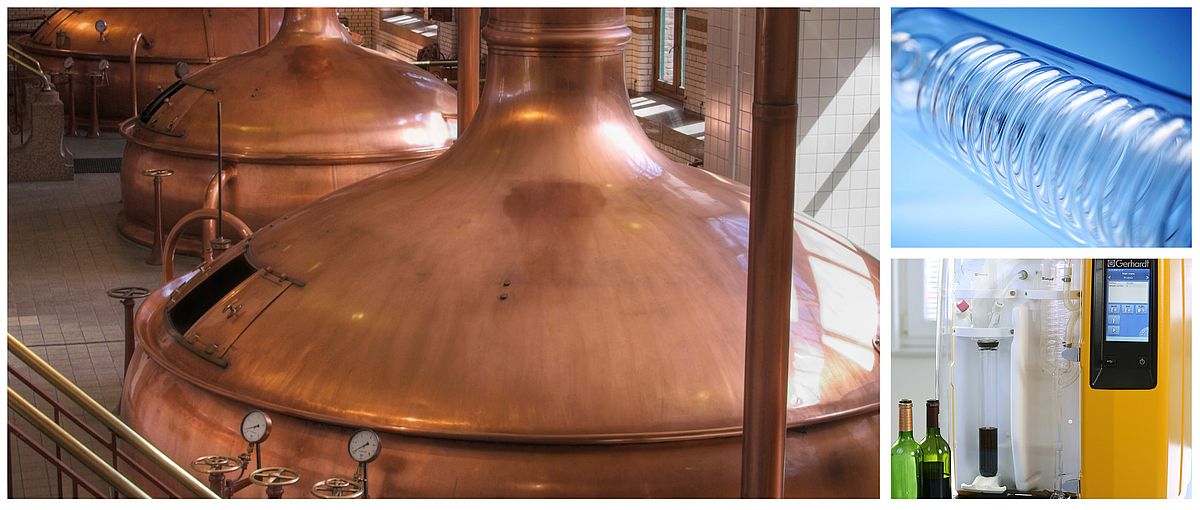Reliable determination of alcohol content as a key indicator of the quality of alcoholic products
Determining the alcohol content (% vol.) in alcoholic beverages is a key element of quality control in the beverage industry. It not only plays a decisive role in complying with legal requirements for labeling, but also for the correct calculation of alcohol tax. The requirements for accuracy are high: even minor deviations can have considerable economic and legal consequences for the manufacturer - from fines and product recalls to cost-intensive relabeling of entire batches.
Measurement is by no means trivial. Alcoholic beverages usually consist of complex matrices which, in addition to ethanol, also contain other ingredients such as sugar, organic acids or aroma components. These components can make it difficult to determine the alcohol content or falsify the measured values. In order to obtain reliable and precise results, suitable analysis methods are therefore required that selectively detect the alcohol component and at the same time eliminate interfering accompanying substances.
Various methods are used in everyday laboratory work, which differ in terms of accuracy, complexity and degree of automation. Traditional methods such as distillation are still widely used, particularly because of their high reproducibility and comparability. At the same time, modern, automated systems are becoming increasingly important, as they save working time and at the same time deliver reliable results - especially with high sample throughputs.
In this application note, we highlight the various common methods for alcohol determination in beverages and show which special features need to be taken into account when analyzing different sample matrices.
Alcohol determination in different beverages
Sample preparation and weighing
Beer: The sample is filtered through a folded filter to remove the carbon dioxide. To support this process, further defoaming can then be carried out in an ultrasonic bath. The sample prepared in this way is now tempered to 20 °C in a 100 ml volumetric flask in a water bath. After thermostatting, the sample is quantitatively transferred to the distillation flask for VAPODEST by rinsing several times with distilled water.
Wine and sparkling wine: After thermostatting, the sample is quantitatively transferred to the distillation flask for VAPODEST by rinsing several times with distilled water. Sparkling wines are treated in the same way as wine, but must be decarbonized beforehand.
- Application note: A spatula tip of bentonite can be added to strongly foaming samples to prevent the formation of foam.
Liqueurs: The sample is tempered to 20°C in a water bath. After thermostatting, 25 ml of the sample is pipetted into a 250 ml Kjeldahl flask. The sample adhering to the edge of the Kjeldahl flask is rinsed with 5-10 ml distilled water if necessary.
Distillation
After sample preparation, the respective sample tube is inserted into the VAPODEST. Program parameters and distillation time are selected according to the sample to be analyzed.
- Application note: The particular advantage of steam distillation over the conventional method for liqueurs lies in the stirring effect of the steam introduced. The sample does not burn and is mixed thoroughly at the same time. The program parameters depend heavily on the expected content. A steam output of 100 % is recommended in these cases. The distillation time and sample quantity must be tested accordingly. Larger glasses can be used if there is a lot of foaming.
Determining the density
Pycnometer method
The pycnometer method is based on determining the density of an alcoholic beverage using a standardized volumetric measuring vessel, the so-called pycnometer. The pycnometer is first filled with distilled water and then with the sample to be analyzed. The density of the sample can be determined from the difference in weight. As the density in alcoholic beverages is significantly influenced by the alcohol and sugar content, the influence of other ingredients must be excluded or taken into account by suitable sample preparation - for example by prior distillation. The method is characterized by its high accuracy, is relatively time-consuming and requires very careful work, especially when controlling the temperature.
Hydrometer method (spindle)
In the hydrometer method, the density of the beverage is determined using a floating body - a so-called hydrometer or spindle - which is immersed in the liquid. The immersion depth depends directly on the density of the sample and can be read off a scale on the hydrometer. This method is comparatively easy to perform and requires little technical equipment. However, its accuracy is limited and strongly dependent on external factors such as temperature, carbon dioxide content and dissolved solids. Therefore, suitable sample preparation, for example by degassing or distillation, is also required here in order to obtain reliable results.
Oscillating U-tube method
The oscillating U-tube method is a modern, physical measuring method in which the density of the sample is determined by changing the oscillation frequency of a hollow body filled with liquid. The higher the density of the sample, the greater the change in the natural frequency of the oscillating body. The measurement is carried out in a temperature-controlled system and provides precise results with a small sample volume. As the method is very sensitive to dissolved substances, the sample is often distilled beforehand in order to determine only the alcohol content. The oscillating U-tube method is particularly suitable for automation and is ideal for routine analyses with a high sample throughput. This is why systems such as the VariDens from Schmidt & Haensch are regularly used in laboratory environments.


![[Translate to English:] [Translate to English:]](/fileadmin/Redaktion/Freigestellte_Produktbilder/web_pic_vapodest_450x450px.jpg)